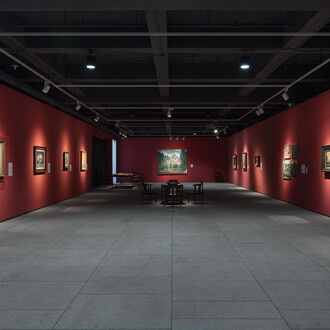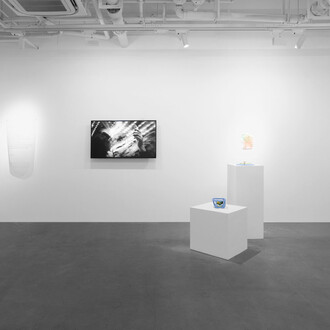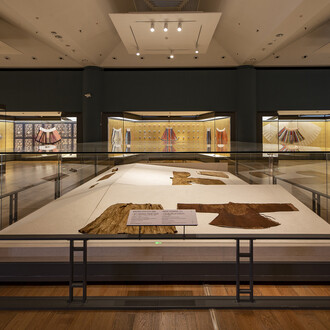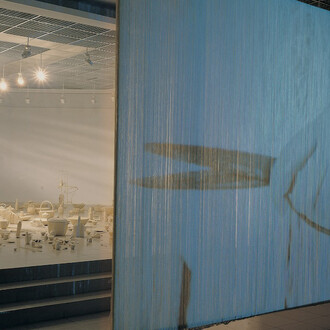The Long Museum (West Bund) in Shanghai is pleased to announce The enchantment, an exhibition by artist Jean-Michel Othoniel. The show brings together two of his most iconic series—the signature beads and bricks—into a cohesive body of work spanning from 2012 to the present. These works are at once geometrical abstractions and luminous, recognizable objects that are delightful and luxurious to behold. Whether seen as an ironic play on utopian ideals or a contemporary tribute to ancient traditions, Othoniel invites viewers to make their own interpretation.
Othoniel’s artworks—exquisitely handcrafted by skilled artisans in Italy and India, and later assembled with the help of engineers in his Paris studio—follow the discipline of modern abstraction with rigorous and highly consistent formal development. Working in glass, he introduces subtle variations to each stacked brick, a ripple effect that casts a sombre and mysterious aura. The brick sculptures appear almost unreal to the eye, as though low resolution digital objects from the virtual world had been brought to life. His monumental glass beads are strung into loops too large to wear, yet the forms still evoke the curve of the invisible neck. The more complex mathematical bead formations suggest the embrace and kiss of bodies, the unfolding of a flower, or the contortion of a dancer suspended in air. Up close, each bead reveals subtle baroque distortions, its unique shape bearing the imprint of the glassblower’s breath and touch.
These luminous works bathe the Brutalist architecture of the Long Museum with an ethereal glow. The light they emit is cool and dreamlike, reminiscent of nocturnal visions. Covertly, by bringing a certain light into the museum, the artist brings the night with it, transforming day into twilight and inviting viewers to revel in the enigmatic wonders.
Creative map
Early on, Jean-Michel Othoniel saw art as a parallel universe and embraced the importance of play, an ethos that would later define his artistic practice. By his late teens, he moved to Paris to study art, arriving in the 1980s, a transformative period in Western art. Movements such as Minimalism, Conceptual Art, Fluxus, the Situationist International, Arte Povera, Land Art, Happenings, and Performance Art had reshaped artistic mediums, with transmedia installations becoming mainstream contemporary art. Yet, even as the freedom of artistic expression expanded, the AIDS crisis brought unimaginable suffering and loss to the gay community, profoundly shaping Othoniel’s worldview. His first works were driven by feelings of despair.
A survey of Othoniel’s artwork reveals a striking interplay between the private and the public, between obscured meanings and universal symbols. His early works in the 1980s explored photography under the title Photographic failures, where he experimented with camera obscura and heliography, the earliest known method of direct exposure to achieve deliberately imprecise results. He arranged objects chosen for their symbolic meaning such as butterflies, sulphur and pomegranate flower, along with blue ferro prussiate glass plates, light and shadow to stage a theater of transformation that explored themes of death and rebirth. It is in these early photographic experiments that we find the origin of the peculiar light that permeates his later works.
In 1997, Othoniel was invited to contribute to a gay pride project. To commemorate artist Félix González-Torres, a friend and a mentor who had died of AIDS the previous year, Othoniel painstakingly hand-crafted 1,000 red glass bead necklaces, Scar necklace (symbolized the scars of loss), and distributed them to the crowd to suggest a collective mourning. His first time using glass as a medium of public engagement, he observed that the beauty of the material served as a protective shield for viewers, a weapon to overcome despair, and perhaps a sign that his underground artistic practice had found an interface to connect with the outside world. This shift in medium pushed him to embrace collaboration, as glass production requires lifelong dedication and expertise that artists must rely on others to achieve. His studio opened up, and his creative steps adopted an architectural methodology, which quantum jumped him onto a different track—one with much greater brightness and visibility. His work took on a more architectural mode of expression, becoming increasingly geometric and abstract.
The later series of large-scale bead sculptures are abstract, function as super low-resolution imaging devices, inviting viewers to fill in the gaps with their imagination. Prayer beads, a universal symbol of infinity, associate to prayers or wishes of people. In Othoniel’s hands, they take on diverse worldly meanings: from paying homage to Arabic calligraphy (Alfa, permanent installation in the lagoon of the National Museum of Qatar Doha, 2019), to evoking the spirit of dance notation in the court of Louis XIV (The beautiful dances, permanent installation in the gardens of the Chateau of Versailles, 2014), to mourning the ghosts of lynched African slaves of New Orleans (The necklace tree, permanent installation at the Sydney and Walda Besthoff Sculpture Garden, the New Orleans Museum of Art, 2003). As if by a miracle, the artist is able to project his imagery onto the screen of the viewer’s mind.
Conceptual genealogy
When the glass brick first appeared, it was shrouded by a net of glass-bead necklaces in Precious stonewall (2010), suggesting an overlap in their significance. Walls and beads may seem like a pair of opposites at first—real vs. imaginary, solid vs. empty, concrete vs. abstract, substantial vs. ephemeral—but in a deeper sense, they become interchangeable, somewhere between building blocks and pixels. The idea of glass bricks emerged during Othoniel’s travels to India. Though he initially traveled to work with glassmakers there, the cultural context was never incidental; it became integral to the work. In India, he observed piles of bricks stacked by the roadside and saw in them projections of people’s hopes and dreams. From this, he distilled a universal form he later called emotional geometry, in order to place the people who are the source of his inspiration on the center stage.
There is a superficial resemblance between a brick wall and the motif of grids in canonical modern painting, yet their underlying consistency is rarely explicitly pointed out. Walls are built to divide and contain, as seen in the Berlin Wall, yet they can also become sites and symbols of gathering, prayer, and protest, like the Wailing Wall, or the Stonewall Movement. If we only look at the cultural significance of walls across cultures, it is no surprise the grid a recurring subject in modern art, attracting artists who devote entire careers to its seemingly rigid and repetitive form. A wall represents both an end and a beginning—a threshold where physical effort ceases and hallucination begins, transforming itself into a screen for collective projections.
Othoniel’s glass brick structures unfocus the eye and consequently the mind through prolonged gazing. This state of visual suspension awakens in the viewer an awareness of the generative power of human sensory perception itself. As the eyes unravel and freely associate, one watches the concrete object dematerialize into pure light and color. Thus, the physical presence of the glass bricks becomes their own dissolution; the once-rigid surface crumbles and reveals a tunnel forged by the sensory organ of the beholder.
On a synesthetic level, the modern grid is a visual beat, a knocking or the echo of footsteps. Othoniel’s enduring desire to overcome boundaries and forge connections resonates deeply with a few brightest moments in art history, such as the works of J.M.W. Turner and Paul Klee, who brought Goethe’s poetic study of human perception into tangible practice. His artistic vision is profoundly autonomous, and his unique path has been organically shaped and inspired by his journeys across the globe. Othoniel’s art speaks in a voice that does not start arguments; to him, communication is akin to making a wish and the absence of a response can hold as much significance. He understands people through attentiveness, regards the body as a reflective medium, and sees communication as intertwined wishes rather than words. Othoniel has crafted his bricks and beads into a medium of emotional deliverance.
(Text by Zhou Yi)
















